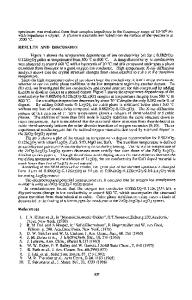Solubility of carbon in CaO-B 2 O 3 and BaO-B 2 O 3 slags
- PDF / 286,258 Bytes
- 8 Pages / 612 x 792 pts (letter) Page_size
- 60 Downloads / 337 Views
I. INTRODUCTION
A new breakthrough in steel materials has been achieved for various applications. For example, super fine and high strength steels have been developed for improving both strength and ductility.[1] For these purposes, the severe control of impurities under the condition of an ultralow level has been required. Therefore, the possibility of control of carbon content in molten steel was suggested, and the solubility of carbon in the molten slags has been investigated by many other researchers.[2–13] In previous works, the solubility of carbon was strongly dependent on oxygen partial pressure[8,10–12] and basicity (aO22) of slags.[6–13] The dependence of carbon solubility on oxygen partial pressure has been known explicitly, while the effect of basicity on carbon dissolution has not been cleared. For example, the solubility of carbon increased by the increase of SiO2 content in the CaO-SiO2-Al2O3 slag,[2,9] while the solubility increased with increasing content of basic oxides in other basic slags. Therefore, it was not clear whether carbon dissolution would be enhanced by the basic or acidic components. In the cases of nitrogen[10,14–17] and silver[18,19,20] dissolution in molten slags, two types of dissolution mechanisms, with variation in the basicity of slags, have been reported. In the present study, the solubility of carbon in the B2O3bearing slags, which had been known to have a wide range of liquids, was measured to understand the reaction mechanism of carbon dissolution into the slags.[21] In addition, the carbide capacity was suggested and compared to the nitride capacity. II. EXPERIMENTAL A superkanthal electric furnace was used for equilibration of molten slag and gas phase. The temperature was controlled within 62 K using an R-type (Pt-13Rh/Pt) thermocouple and a proportional-integral-differential (PID) controller. The slag samples were prepared using reagent-grade BaO, B2O3,
and CaO calcined from CaCO3. The schematic diagram of the experimental apparatus is shown in Figure 1. The slag samples of 10 g were held in graphite crucibles under CO atmosphere for controlling oxygen partial pressure by C/CO equilibrium, as shown in Eq. [1]. C (s) 1
1 O (g) 5 CO (g) DG8 5 2114,000 2 2 2 85.8 T (J/mol)[22]
For measuring the effect of oxygen partial pressure on the solubility of carbon, a mixture of CO and Ar was supplied by using MFC (Matheson, model 8284 (Montgomeryville, PA)). The impurities of CO and Ar were removed by passing through CaSO4, Na2O ? CaO, silica gel, and, especially, Mg turnings at 753 K for Ar. The time for equilibration was predetermined to be 18 hours, as shown in Figure 2. After equilibrating, the samples were quenched by Ar gas and crushed for chemical analysis. The content of carbon in slags was determined by a LECO* *LECO is a trademark of LECO Corporation, St. Joseph, MI.
(CS-300) analyzer. The uncertainty of the measured data could be estimated to be about 63.25 pct. Therefore, it could be concluded that the experimental data in the present work is reproducible. The pos
Data Loading...











